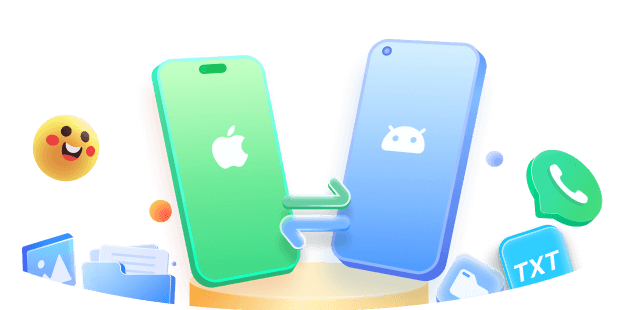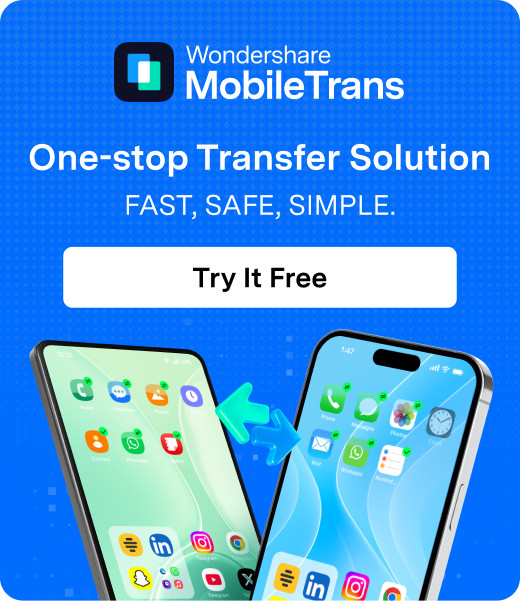Many people switch to new phones but are usually unsure about the available mediums to move their data and other files to a new device. Consequently, they usually have to leave their data behind or delete it permanently before moving to the new phone. Yet, Android phones come with various methods and support multiple migration tools to ensure users can safely switch between phones.
Since this issue disturbs most users switching to a new phone, this guide will explain the process to transfer data from Android to Android. We will also talk about cloud storage options and other direct methods that require no technical knowledge. In addition to this, the article will explore an advanced approach that enables data migration and backup features across various devices.
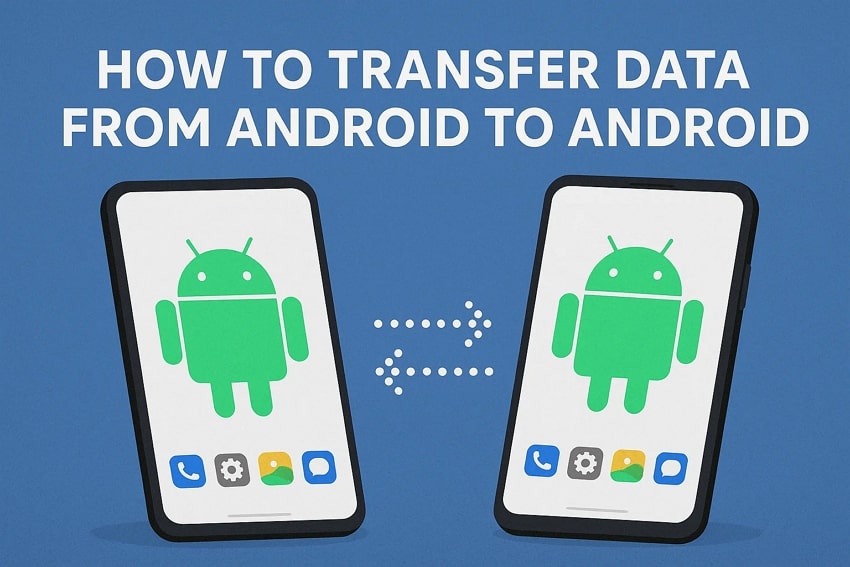
In this article:
Part 1. Move Everything from Android to Android in One Click: MobileTrans [100% Working]
Data Types: Calendar, contacts, call logs, messages (SMS), photos, videos, music, notes, bookmarks, apps (Android only), etc.
As the quickest solution on the list, MobileTrans is the recommended third-party solution that enables the transfer of data between phones at an average speed of 30MB/s. The solution works for data migration between 6000+ devices, which involves both Android and iOS phones from older and newer generations. Furthermore, its support for 18 data types ensures nothing is left behind during your transfer to a new device.
It not only allows data transfer from Android to Android, but it also facilitates moving your iCloud data to an Android phone without operating system clashes. Since it doesn’t depend on the internet to migrate data, users can expect quicker and safer transfers. In addition to helping with migration, the tool has advanced backup and restore features to preserve the data in a local system for later use.
Key Features
- WhatsApp Transfer: Users can securely move their messages and shared media files to a new device without cloud backups.
- App Transfer: Apart from WhatsApp, specific applications like Line and Viber can also be moved using this solution.
- iTunes Restore: In addition to iCloud, the app supports moving data out of iCloud and saving it on an Android device.
Guide to Using MobileTrans to Move Everything from Android to Android
Although it is an outside solution, MobileTrans still ensures you can transfer content from Android to Android without security concerns. The following section contains a detailed guide to help you use this tool for data migration purposes:
Step 1. Access the Phone-to-Phone Transfer Feature
Open the tool and connect both phones to your PC or MacBook. Go to the “Phone to Phone” tab.

Step 2. Switch the Direction of Transfer and Select the Data
Use the "Switch" button to change the transfer direction. Choose the data types and hit the "Start" button.

Step 3. Let the Tool Migrate Your Data
Remove devices once the data migration process ends.
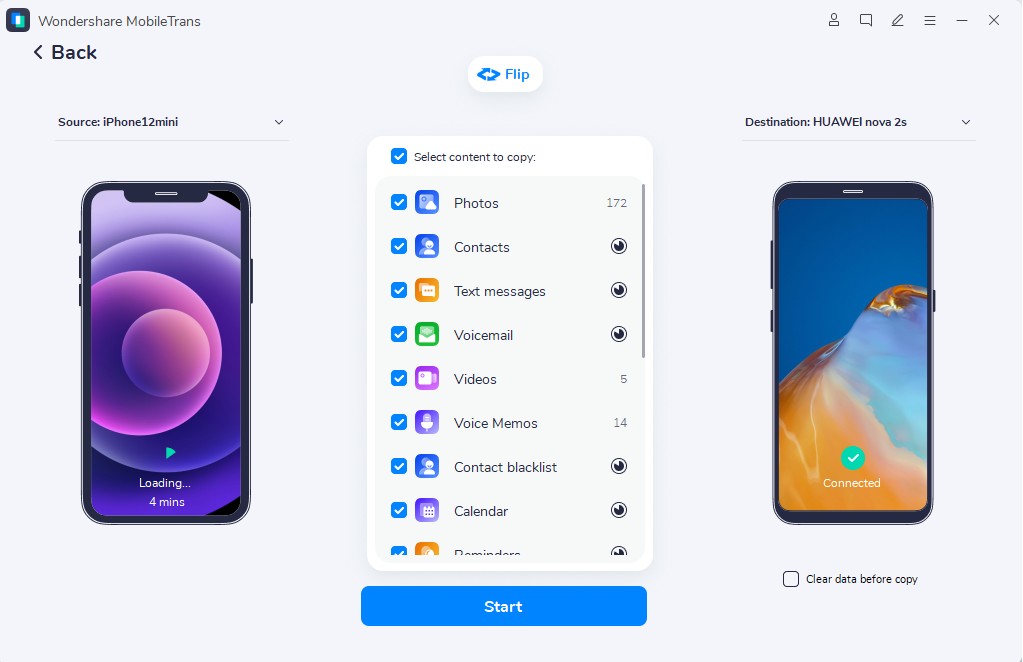
Part 2. Move Everything from Android to Android Using Android Switch
Data Types: Apps, contacts, photos, videos, audio, SMS, MMS, wallpapers, call history.
Another solution that comes built-in in Android is Android Switch, which allows the movement of data from an old device to a new one. The solution ensures data safety during the migration process by creating a private wireless connection. Android Switch allows both wired and wireless options to move the data. It is ideal since it helps bring all data, including messages and contacts, to the new phone.
Key Features
- Let you choose what data you want to move to the other device and what to leave behind.
- It ensures the upcoming data merges with the older files rather than overwriting them with new information.
- Users can move their MMS attachments with this built-in Android application.
Guide to Move Everything from Android to Android Using Android Setup
Upon learning about the usefulness of the Android Switch application, follow the given steps to use it for data transfer from Android to Android:
Step 1. On the old phone, open the app and press “Copy Data.”
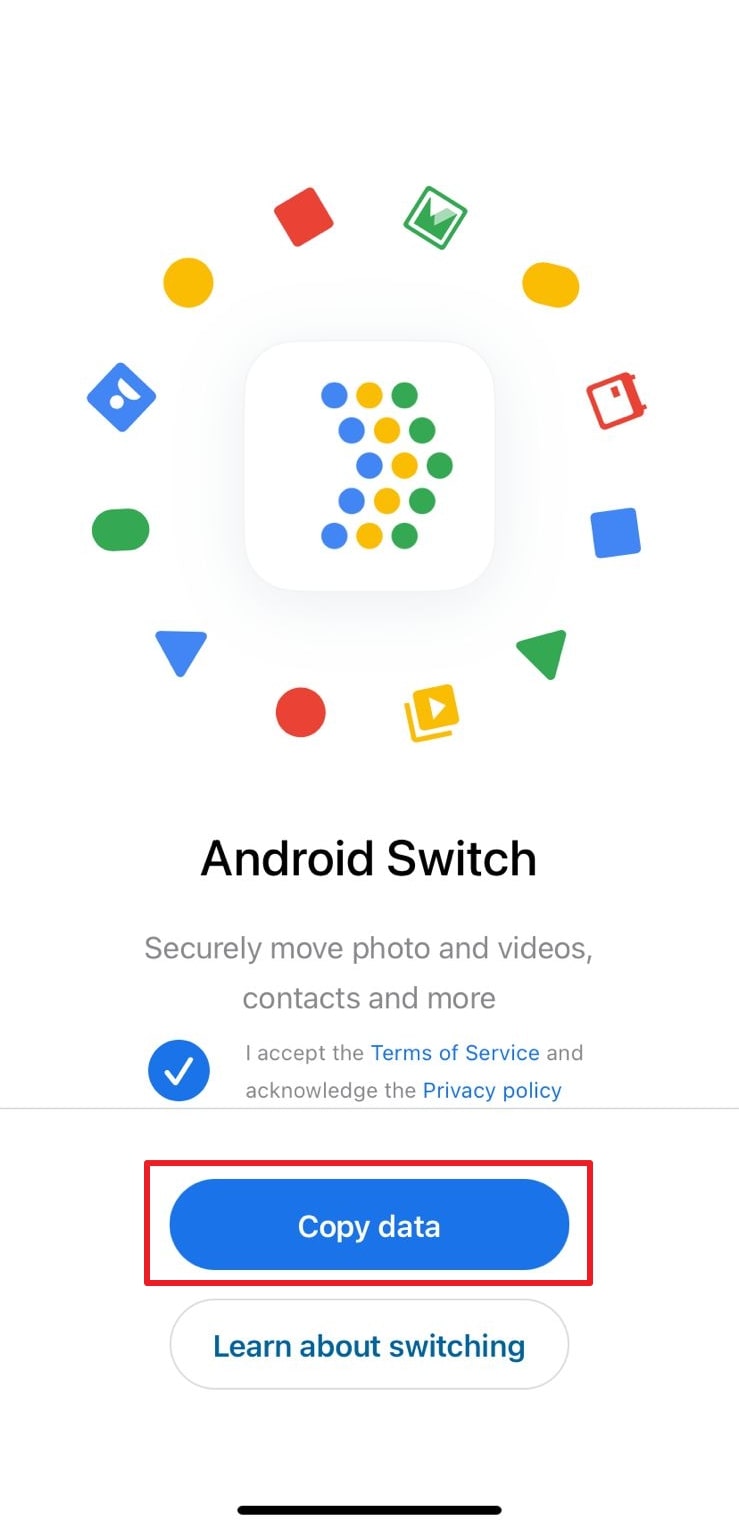
Step 2. Press “Get Started” on the new phone. Tap “Next” on the upcoming two screens and choose “No Cable.”
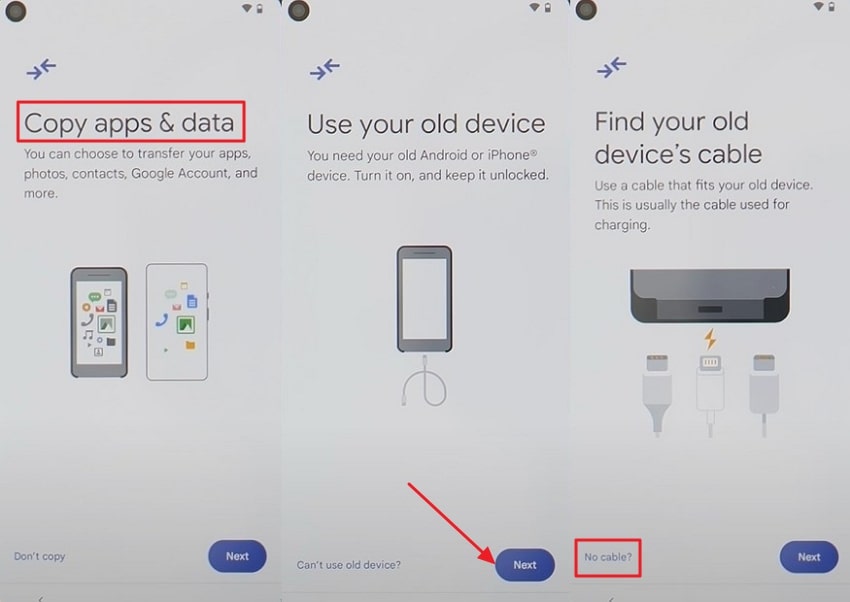
Step 3. Press Continue > Receive QR code > Scan with the old phone and hit the “Join” button.
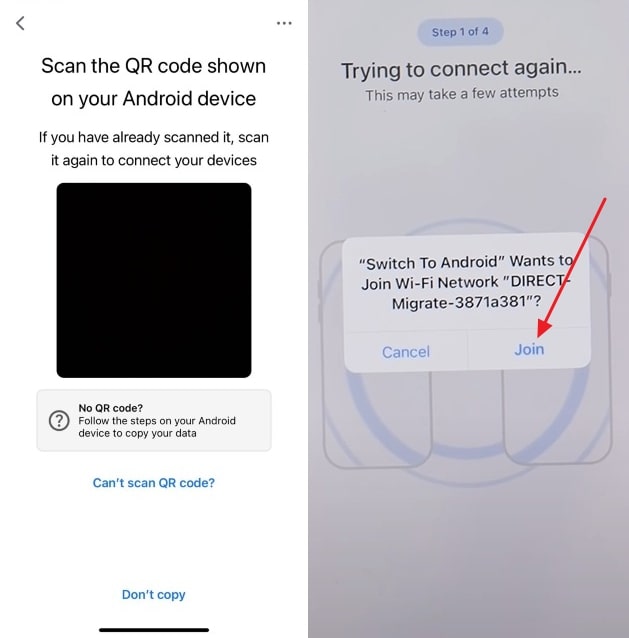
Step 4. Tap “Ok” for network access. Choose all data types and press “Continue.” Pick the “Start Request” button.
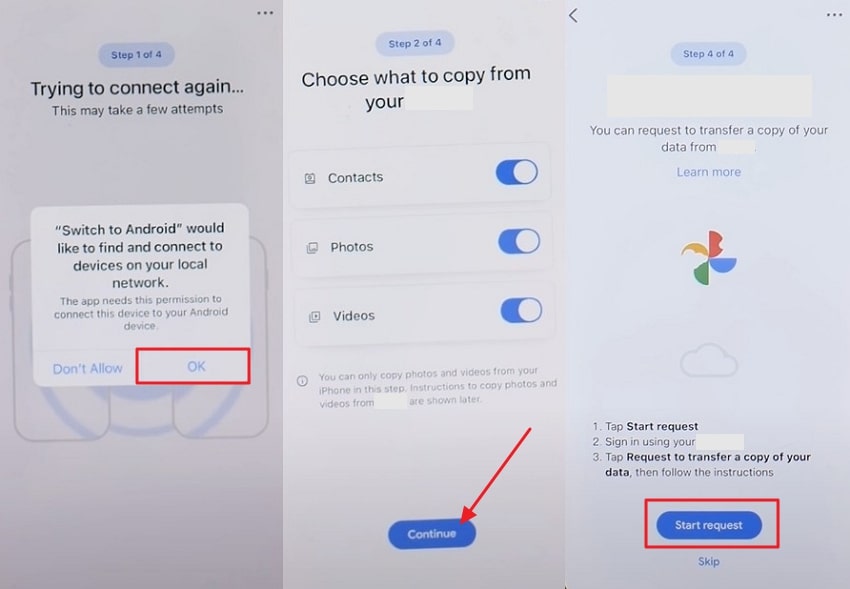
Part 3. Use QuickShare to Transfer Data from Android to Android
Data Types: Photos, videos, documents, APKs, etc.
The QuickShare allows users to move everything from Android to Android using its built-in feature to share photos, videos, and data via Bluetooth and QR code scanning. It is the best method to transfer as it doesn’t need any cable or third-party app and allows you to transfer during an airplane via Bluetooth. This way of transferring data is the safest, as it allows the user to select the receiver.
Key Features
- Transferring data through QuickShare ensures file security, especially since it works through QR codes.
- This way of transferring data consumes less battery for small files compared to other wireless methods.
- During the transfer using this method, the sender and receiver both approve the file transfer before sharing it to ensure intentional sharing.
Guide to Transfer Data from Android to Android Using QuickShare
After learning about QuickShare, let’s know about how to transfer content from Android to Android using the above method with the following steps:
Step 1. Select the files > press the “Share” button > and choose “QuickShare.”
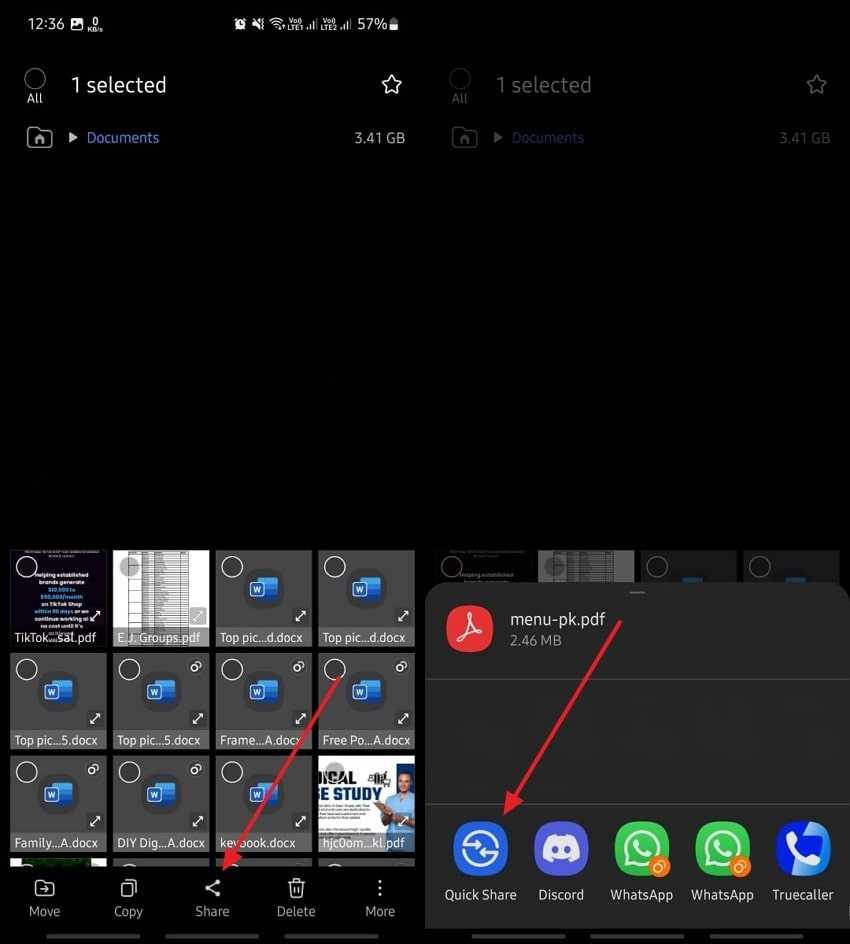
Step 2. Press the “Turn on Bluetooth” button and select the receiver device.
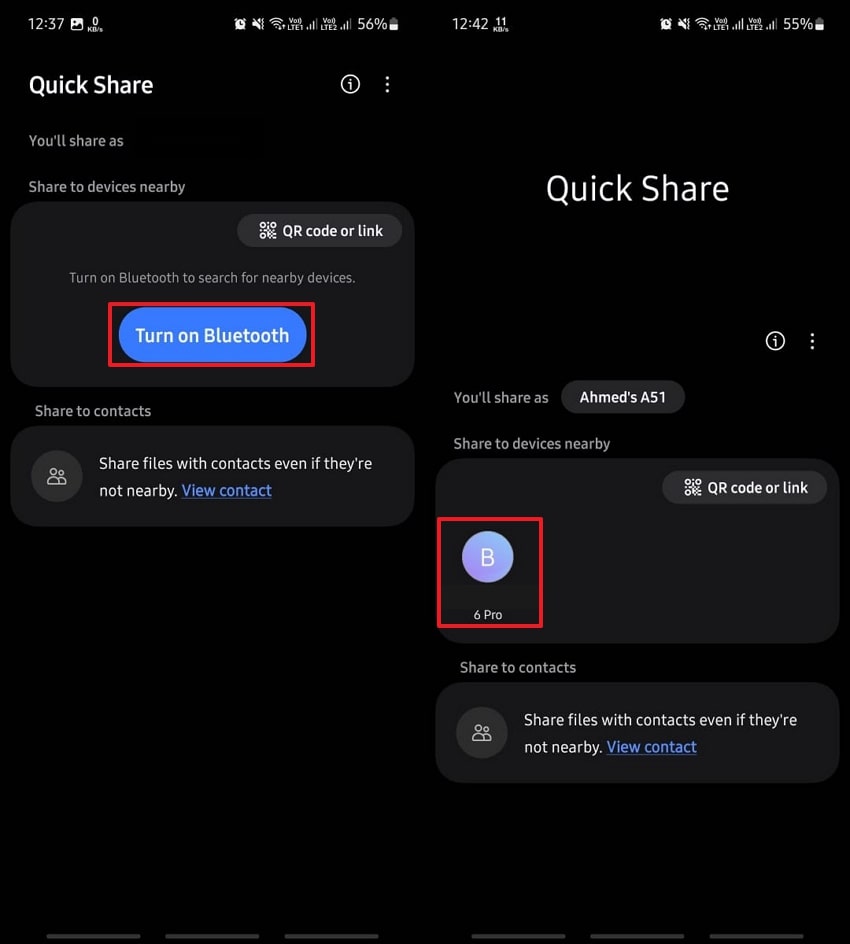
Step 3. Select “Everyone” and then hit “Done” on the receiver’s device. Then press the “Accept” button.
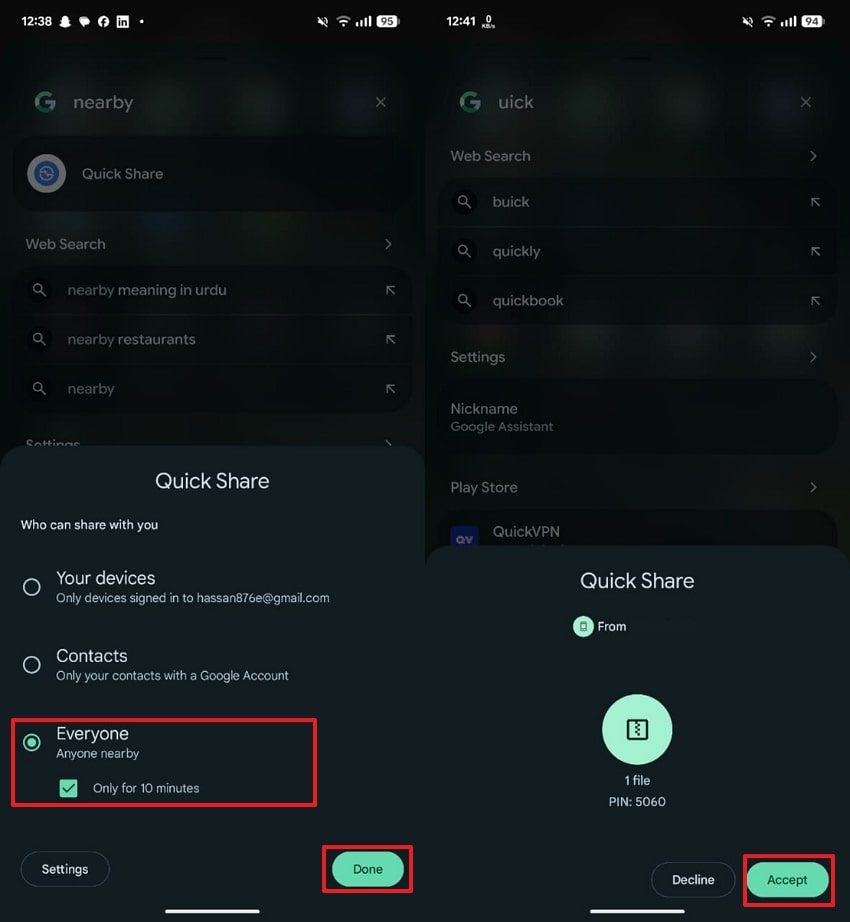
Part 4. How to Sync from Android to Android via Google Sync
Data Types: App data, contacts, calendar, photos, videos, audio, text messages, call history, some phone settings, etc.
Google Sync is a cloud-based service that backs up and syncs data for devices that use a Google account. This service works with the same Google account and ensures the data is always backed up. In addition to allowing automatic backups, it supports choosing specific data types for backup. Being cloud-based, this data transfer content from Android to Android reduces the risk of data loss while storing backups.
Key Features
- This feature allows you to connect on multiple devices by using the same Google account to have consistent data across all of them.
- It allows you to customize the data sync by selecting the data of your choice that you want for backup.
- Using end-to-end encryption ensures not even Google can access your data while it is sitting in the Drive.
Guide to Sync from Android to Android via Google Sync
To sync data from Android to Android via Google Sync, you need to follow these steps:
Step 1. Open the settings and reach "Google.” Press the "Manage Backup" button. Then, hit the “Backup Now" button.

Step 2. Log in to your Google account on a new device. During the setup, press "Next" on the "Copy Apps and Data" screen. Select the backup to restore.

Part 5. Transfer Content from Android to Android with a USB Cable
Data Types: Photos, videos, music, contacts, documents, folders, and other media content.
The fastest and most reliable way to switch data from Android to Android is by physically connecting both phones using a USB cable. Although it has limited file type support, it ensures faster speed than other methods and more security. Since the transfer process cannot be hijacked, it is preferred for large and confidential data migrations from old devices to new ones.
Key Features
- USB cables offer high-speed data transfer, ensuring data integrity as they reduce the risk of interference.
- Most Android devices automatically detect other phones when connected via a USB cable, which allows access to data without any setup.
- This method allows the user to transfer an entire folder with different file types at once, as data is transferred directly between devices.
Guide to Transfer Content from Android to Android with a USB Cable
To transfer the data using a USB cable, you need to follow the steps below:
Instructions. Connect both phones using a direct cable connection. Select the file to be transferred > Press Three Dots > Select the “Copy To” option. Then, enter the desired folder and press the “Copy” button.
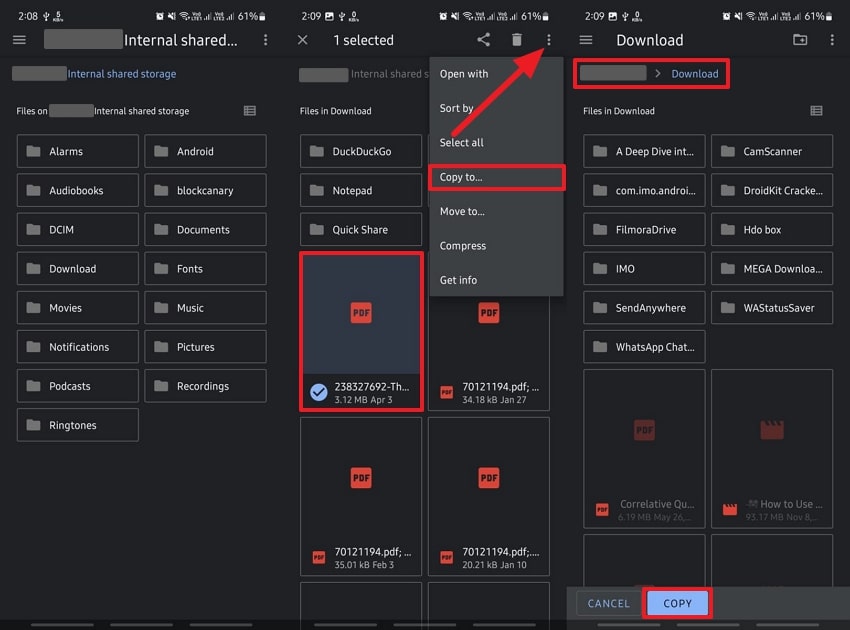
Part 6. Use Native Transfer Apps to Switch Data from Android to Android
Data Types: Settings, home screen, images, videos, audio, documents, files, apps, etc.
Most Android brands have their own dedicated migration tools for their ecosystem along with their data. Samsung users can take advantage of the Smart Switch, while Phone Clone is the dedicated solution for Huawei devices. Among all options, Smart Switch provides extensive support for different data types, and using it to move everything from Android to Android is very simple.
Key Features
- This app usually has a specific feature to move your accounts to the new device.
- Users can migrate their device settings and import them to their new device with Smart Switch.
- It allows wired and wireless transferring options, depending on the users’ needs.
Guide to Using Smart Switch to Switch Data from Android to Android
Users can follow the guiding steps that are outlined in the following section to learn how to transfer content from one Android phone to another:
Step 1. Utilize the “Send from This Phone” button on the old device. Select the “Cable” transfer option.
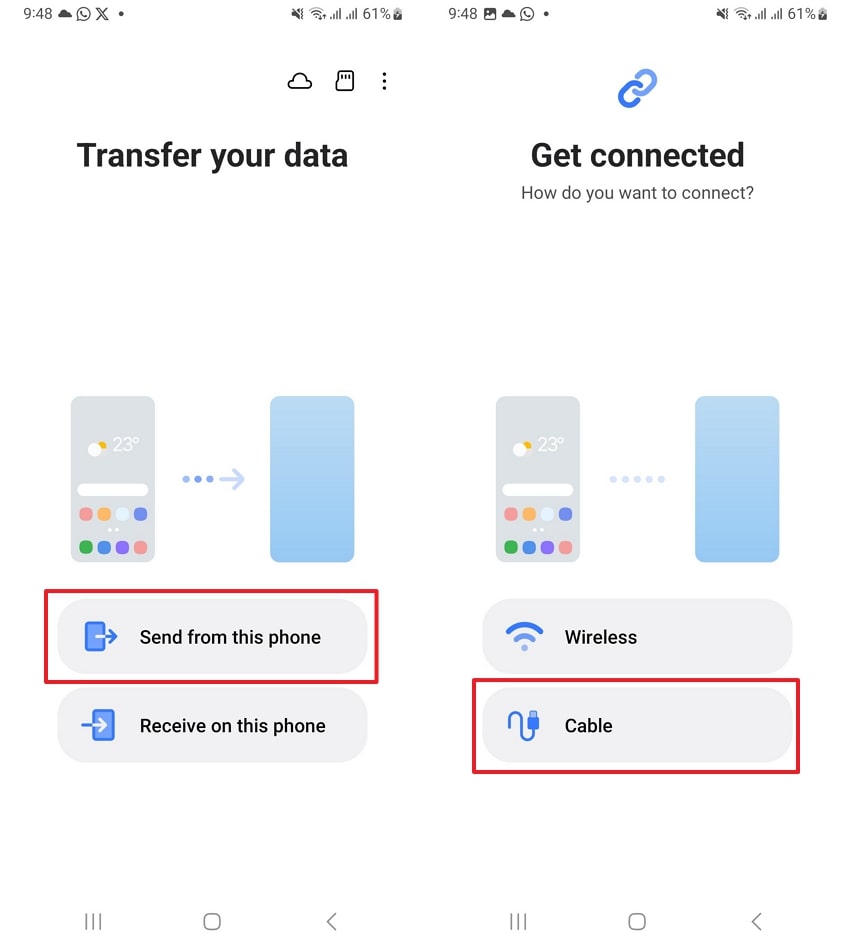
Step 2. Hit the “Receive on this Phone” button on the new phone. Use a cable to connect both phones.

Step 3. Press the "Custom" option and tap the “Next” button. Mark all the required data and hit the “Transfer” button.
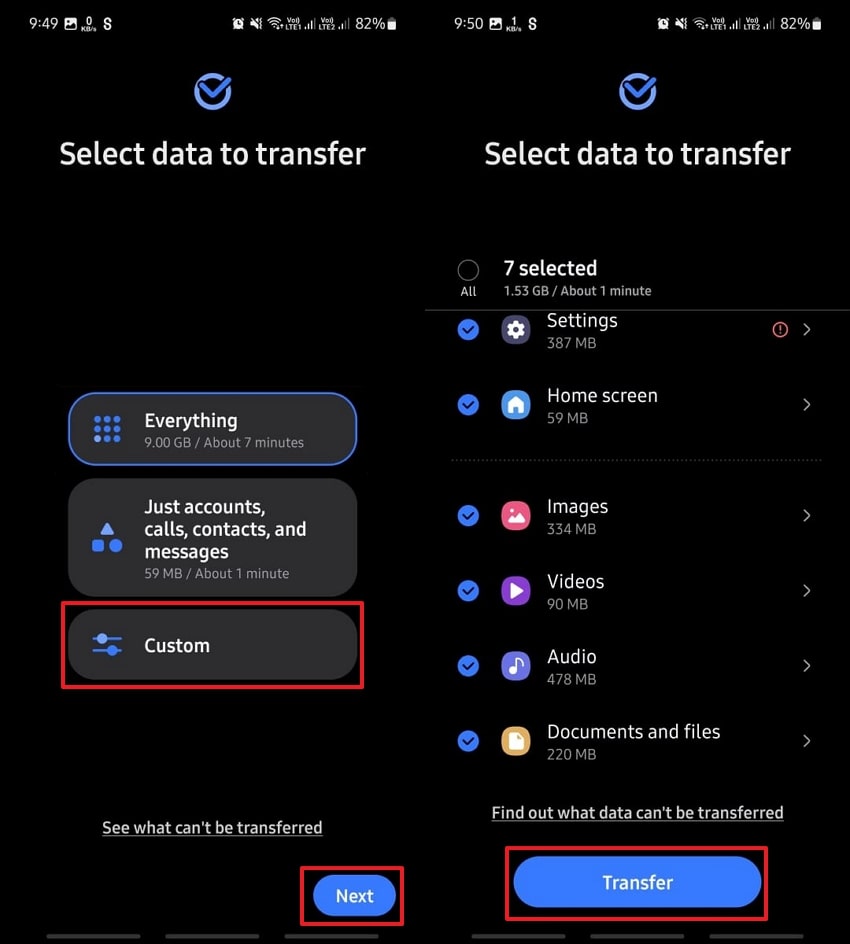
Part 7. How to Transfer Data from One Android Phone to Another via Social Messaging Apps
Data Types: Photos, videos, audio, contacts, documents, APKs.
Another secure way to migrate data to a different phone is by sending the files using a social messaging app. Platforms such as WhatsApp and Messenger allow users to start conversations and send documents and media to each other. Their strong encryption policies ensure your data stays secure within the chat. Furthermore, these apps allow file sharing to your account, which further helps with ensuring data stays with you.
Key Features
- These apps ensure the document quality remains the same when transferred to a different phone.
- The backup feature is also helpful as it restores the whole data to a new device, along with conversations.
- Messaging platforms allow sending files to multiple people and devices at once.
Guide to Transferring Data from One Android Phone to Another via Social Messaging Apps
With the support for the secure transfer of various data types, here is a guide explaining how to transfer data from Android to Android wirelessly using WhatsApp:
Step 1. Enter the chat and press the “Attachment” icon. Choose “Document.”
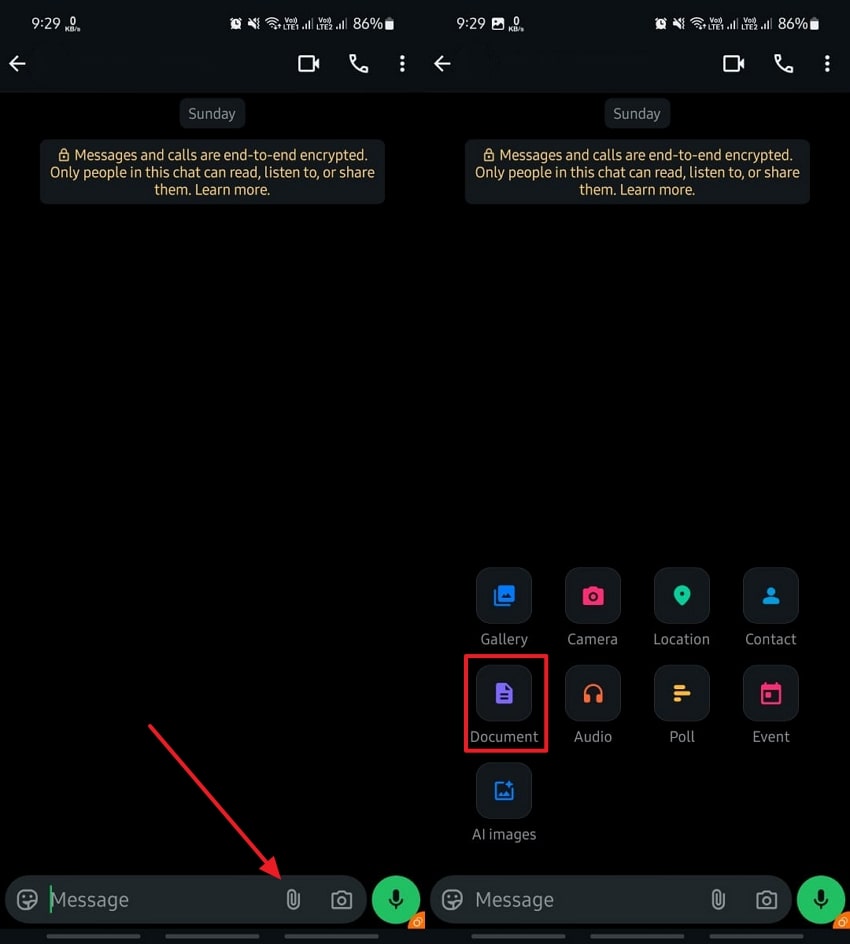
Step 2. Select whatever you need to transfer. Press the “Send” button.
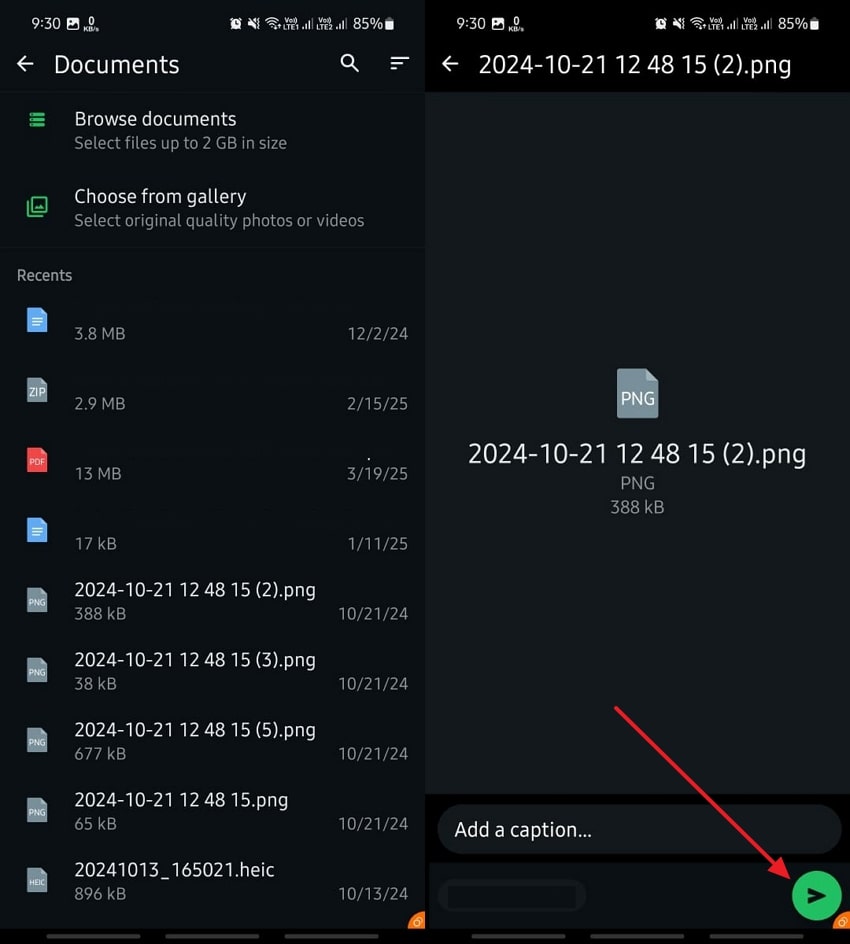
Part 8. How to Transfer Data from Android to Android via Email
Data Types: Photos, videos, documents, and links.
Sending files through mail is another option that you can avail of while you switch data from Android to Android. This should be preferred for small files that are high priority and need more secure transfers, as it is a highly encrypted method. Furthermore, the solution ensures the data remains available for later by keeping it in the records until users manually delete it.
Key Features
- You can send data to multiple files at once to speed up the process.
- Emails usually come with their own cloud storage, which ensures files stay saved.
- Transferred data is saved in the “Sent” folder, providing a record of what was shared and when it was shared.
Guide on How to Transfer Data from Android to Android via Email
To know how to transfer data from Android to Android wirelessly using Email, follow the given steps:
Step 1. Select the files and press the “Share” button. Choose “Gmail” and enter the receiver’s email. Press “send.”
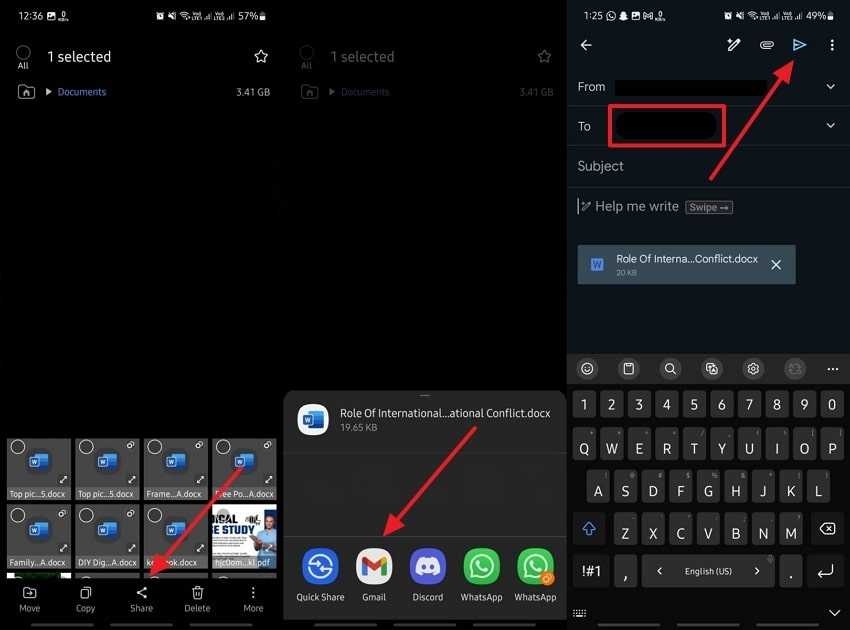
Step 2. Open the mail on the new Android phone and press the "Download" icon.

Part 9. Opting for a Cloud Service to Transfer Data from Android to Android
Data Types: Archive (.ZIP, .RAR), audio, images, videos, text files, Apple formats (Keynote, Numbers), Adobe files, code files (.CSS, .HTML, .PHP), Microsoft files, etc.
Cloud storage services are another ideal way to transfer data from Android to Android, especially if you have a solid connection. Such services from Google and OneDrive support almost all data types, and even complete IT systems can be transferred. All you need to do is upload the file from one device and receive it on the other through syncing technology.
Key Features
- Files saved in cloud storage can be accessed not only on mobile phones but also on desktops.
- These storage options also allow real-time collaboration to edit and add files and documents.
- Many of these cloud options provide users with some amount of free storage.
Guide to Using a Cloud Service to Transfer Data from Android to Android
Since Google Drive comes with most Android devices pre-installed, let’s learn about how to switch data from Android to Android using the tool:
Step 1. Open “Google Drive” and tap the “+” > “Upload” buttons. Select the data and press the “Upload” button.
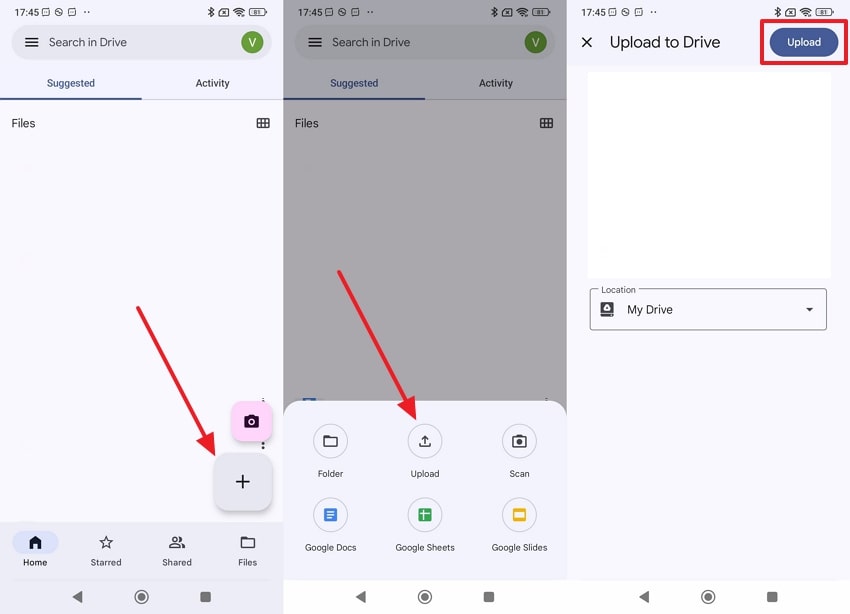
Step 2. On the new device, open “Drive.” Press “Three Dots” beside the targeted file and choose “Download.”
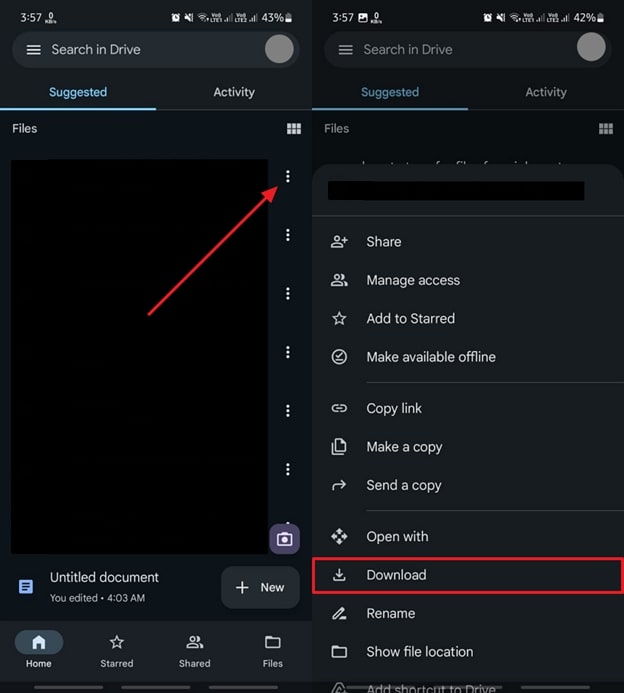
Conclusion
To conclude, multiple solutions exist that allow users to transfer data from Android to Android without losing anything in the process. Cloud options that sync files across devices and brand-specific mobile applications exist that support data migration. However, since all these solutions come with limitations, users are recommended to use alternatives like MobileTrans due to its extensive support and extended features.

